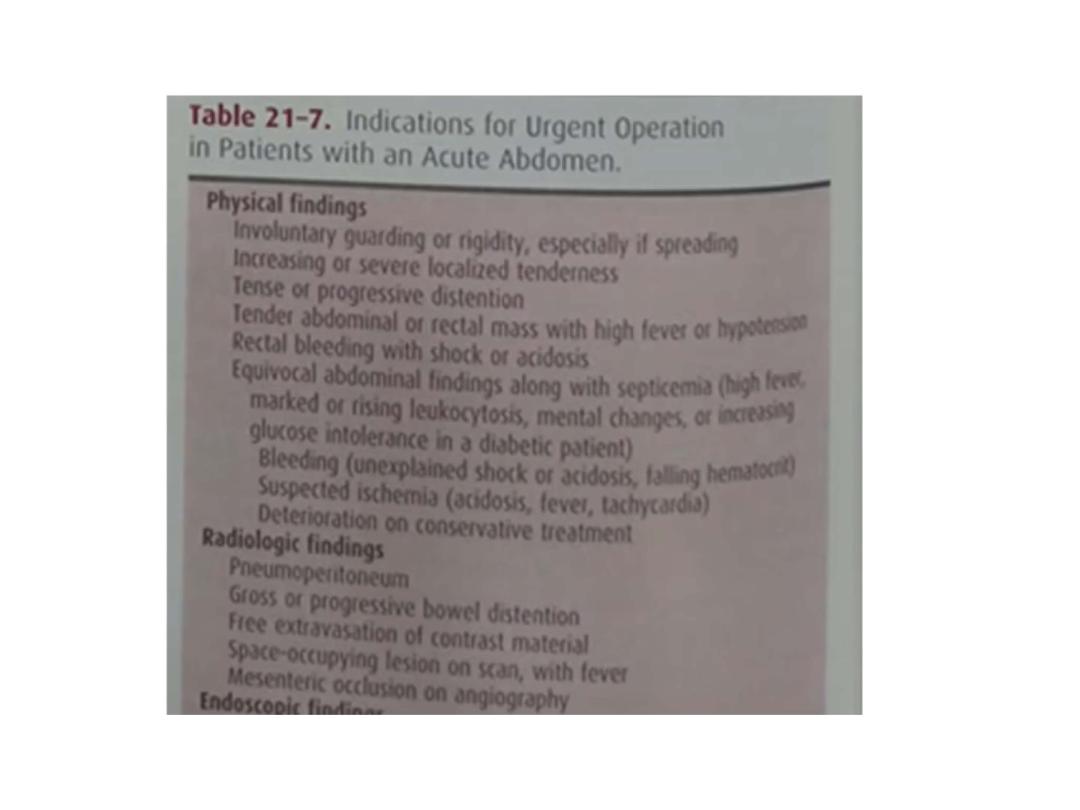
Medical causes of acute abdomen
a-Endocrine &metabolic disorders Uraemia,diabetic crisis
,addisonian crisis ,acute intermittent porphyria, acute
hyperlipoproteinemia, hereditary medetran
i
an fever
b-lnfections and inflammatory disorders Tabes
dorsalis,herpes zoster,acute rheumatic fever, Henoch
Shonlein purpura ,SLE,polyarteritis nodosa
c-Hematolo2ical disorders Sickle cell crisis, acute
leukemia, other dyscrasias
d-Toxins and drugs: Lead and other heavy metal
poisoning, narcotic withdrawal ,black widow (spider
poisoning)
e-Referred pain from thoracic region: myocardial
infarction, acute pericarditis, pneumonia ,pleurisy,
pulmonary embolus ,pneumothorax ,empyema

Physical signs in
various causes of
Perforated viscus : Scaphoid tense abdomen, diminished bowel
sounds(late), loss of liver dullness , guarding or rigidity
Peritonitis : Motionless, absent bowel sounds(late) cough and
rebound tenderness , guarding or rigidity
Inflamed mass or abscess: Tender mass(abdominal,rectal or
pelvic),special signs (murphy 's,psoas or obturator)
Intestinal obstruction: Distension , visible peristalsis(late) ,
hyperperistalsis(early) or quiet abdomen (late),diffuse pain without
tenderness; hernia or rectal mass(some)
Paralytic i leus: Distension, minimal bowel sounds, no localized
tenderness
lschemia or strangulated bowel : Not distended(until late), bowel
sounds variable,sever pain but little tenderness, rectal bleeding
(some)
Bleeding: Pallor ,shock, Distension, pulsatile(aneurysm) or tender
mass(e.g ectopic pregnancy); rectal bleeding

Other Symptoms of acute abdomen
A
Anorex
i
9 ,na1Jsea ., vomiting ,constipati.on
l
or Sii:lrrhoe
-
v
om
1
t1ng pa1n 1n the acute surg1ca audomen
usually precedes vomiting, whereas the reverse
holds true in medical conditions . Vomiting is a
prominent symptom in upper gastrointestinal
diseases (acute gastritis, pancreatitis)
B-Diarrhea: Copious watery diarrhea is
characteristic o f gastroenteritis and other
medical causes of acute abdomen .blood stained
diarrhea suggest ulcerative colitis ,Crohn
disease, bacillary or amebic dysentery .

• B-
constipation
Reflux ileus is of ten induced by visceral
afferent fibers stimulating efferent fibers of
the sympathetic nervous system to reduce
intestinal peristalsis.
Opstipation (the absence of both stool and
flatus) strongly suggest mechanical bowel
obstruction if there is progressive painful
abdominal distention or repeated vomiting

Laboratory Investigations
a-blood studies Pcv, wbc,clotting specific tests
differential count, urea ,creatinine
( crossmatching * arterial gases*)
b- urine test Microscopy, dipstick testing ,culture
c- stool exam: Occult blood, warm smear,c ulture
d-imaging studies: chest -abd x ray , US,or CT
scan (,angiography, water soluble upper
gastrointestinal series,HIDA scan)
e-endoscopy, paracentesis
,
laparoscopy

Differential diagnosis
The age and gender of the patient help in the differential diagnosis:
Mesenteric adenitis mimics acute appendicitis in the young
gynecologic disorders complicate the evaluation of lower abdominal
pain in women of childbearing age, and malignant and vascular
diseases are more common in the elderly.
(1) Any patient with acute abdominal pain persisting for over 6 hours
shoul
d
be regarded as having a surgical problem requiring in-hospital
evaluation. Well
-
lo
ca
lized pain
a
nd tenderness usually inaicate a
surgical condition. Systemic hypoperfusion in conjunction with
generalized abdominal pain is seldom due to a nonsurgical problem.
(2) Acute cholecystitis, appendicitis, bowel obstruction, cancer, and
acute vascular conditions are the most common causes of the surgical
acute abdomen in older patients.
(3) Salpingitis, dysmenorrhea, ovarian lesions, and urinary tract
infections complicate the evaluation of the acute abdomen in young
women.

(4) Unusual types or atypical manifestations of
intestinal obstruction, especially early cases, are easily
missed. Emesis, abdominal distention, and air-fluid
levels on x-ray may be negligible in Richter hernia,
proximal or closed-loop small bowel obstructions, and
early cecal volvulus.
5) Elderly or cardiac patients with severe unrelenting
diffuse abdominal pain but without commensurate
peritoneal signs or abnormalities on plain abdominal
films may have intestinal ischemia. Arterial blood pH
should be measured and visceral angiography
perf armed expediently.
(6) Medical causes of the acute abdomen should be
considered and excluded if possible before exploratory
laparotomy is planned .


PERIOPERATIVE MANAGEMENT
• After initial assessment ,
_
parenteral analgesic for pain
relief should not be withhe
l
d. pain that persist in
spite of adequate doses of narcotics suggest a serious
condition often requiring operative correction.
• Resuscitation of acutely ill patients should proceed
based on their intravascular fluid deficits and
systemic diseases.
• Medications should be restricted to only
essentials;cardiac drugs, corticosteroids,& to control
diabetes.
• Antibiotics are indicated for some infectious
conditions or as prophylaxis during the perioperative
period.

questions
1- differentiate between parietal and
visceral pain.
2- enumerate 5 common medical causes of
acute abdomen
3- how the age can be of help in diagnosing
acute abdomen?
4- intestinal obstruction can be missed
explain why?
